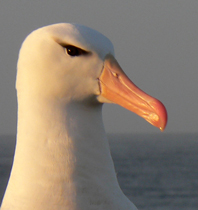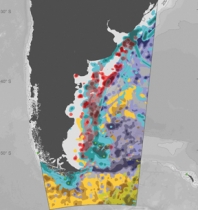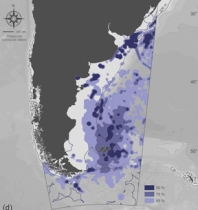|
 |
 | Black-browed albatross (Thalassarche melanophrys).  |
 |
The map shows the areas of use for 5 species of albatrosses from colonies on the Malvinas Islands, South Georgia, southern Chile and New Zealand: Black-browed albatross (turquoise), Northern Royal albatross (red), Wandering albatross (blue), Grey-headed albatross (yellow) and Light-mantled albatross (green). The areas of greatest importance are the continental slope and the shelf waters east of the Río de la Plata, San Jorge Gulf and Valdes Peninsula.
All available data between January and December were used in the analysis, without distinguishing between seasons.
Dataholders: J. Croxall, R. Phillips and P. Trathan (Wandering albatross); D. Nicholls and C.J.R. Robertson (Northern Royal albatross); J. Croxall, R. Phillips, P. Trathan, J. Arata, C. Moreno and G. Robertson (Grey-headed albatross); J. Croxall, N. Huin, R. Phillips, P. Trathan, J. Arata, C. Moreno and G. Robertson (Black-browed albatross); P. Trathan and R. Phillips (Light-mantled albatross).
| © Flavio Quintana |
 |
Principal feeding areas |
 Seasonal Use (Spring) Seasonal Use (Spring) |
During the southern spring (October-December) the albatrosses concentrate in the northern zone of the slope (opposite the Río de la Plata), off the Valdes Peninsula and off southern Chile.
Data on 4 species of albatrosses: adults and juveniles of Northern Royal albatross and Black-browed albatross, adults of Wandering albatross and Grey-headed albatross. All available data, 281 trips in spring, were used in the analysis.
Dataholders: J. Croxall, R. Phillips and P. Trathan (Wandering albatross); D. Nicholls and C.J.R. Robertson (Northern Royal albatross); J. Croxall, R. Phillips, P. Trathan, J. Arata, C. Moreno and G. Robertson (Grey-headed albatross); J. Croxall, N. Huin, R. Phillips, P. Trathan, J. Arata, C. Moreno and G. Robertson (Black-browed albatross).
 |  Seasonal Use (Summer) Seasonal Use (Summer) |
During summer (January-March), the principal areas visited by the albatrosses are the continental shelf and slope, opposite the San Jorge Gulf, Valdes Peninsula, Malvinas Islands and the waters to the south of the Antarctic Polar Front.
Data on 5 species of albatrosses: adults and juveniles of Northern Royal albatross and Black-browed albatross, adults of Wandering albatross, Grey-headed albatross and Light-mantled albatross. All available data, 394 trips in summer, were used in the analysis.
Dataholders: J. Croxall, R. Phillips and P. Trathan (Wandering albatross); D. Nicholls and C.J.R. Robertson (Northern Royal albatross); J. Croxall, R. Phillips, P. Trathan, J. Arata, C. Moreno and G. Robertson (Grey-headed albatross); J. Croxall, N. Huin, R. Phillips, P. Trathan, J. Arata, C. Moreno and G. Robertson (Black-browed albatross); P. Trathan and R. Phillips (Light-mantled albatross).
 Seasonal Use (Autumn) Seasonal Use (Autumn) |
In autumn (April-June) the principal feeding areas for the albatrosses cover different areas of the slope.
Data on 5 species of albatrosses: adults and juveniles of Northern Royal albatross and Black-browed albatross, adults of Wandering albatross, Grey-headed albatross and Light-mantled albatross. All available data, 105 trips in autumn, were used in the analysis.
Dataholders: J. Croxall, R. Phillips and P. Trathan (Wandering albatross); D. Nicholls and C.J.R. Robertson (Northern Royal albatross); J. Croxall, R. Phillips, P. Trathan, J. Arata, C. Moreno and G. Robertson (Grey-headed albatross); J. Croxall, N. Huin, R. Phillips, P. Trathan, J. Arata, C. Moreno and G. Robertson (Black-browed albatross); P. Trathan and R. Phillips (Light-mantled albatross).
 |  Seasonal Use (Winter) Seasonal Use (Winter) |
In winter (July-September) the main concentrations of albatrosses are on the continental shelf, opposite the Río de la Plata and south of Buenos Aires, and on the slope, opposite the San Jorge Gulf and around the Malvinas Islands.
Data on 4 species of albatrosses: adults and juveniles of Northern Royal albatross and Black-browed albatross, adults of Wandering albatross and Grey-headed albatross. All available data, 89 trips in winter, were used in the analysis.
Dataholders: J. Croxall, R. Phillips and P. Trathan (Wandering albatross); D. Nicholls and C.J.R. Robertson (Northern Royal albatross); J. Croxall, R. Phillips, P. Trathan, J. Arata, C. Moreno and G. Robertson (Grey-headed albatross); J. Croxall, N. Huin, R. Phillips, P. Trathan, J. Arata, C. Moreno and G. Robertson (Black-browed albatross).
|
 |
Albatrosses
The Patagonian Sea is regularly used by at least 5 albatross species, and visited by other 5 or so species. The Black-browed albatross (Thalassarche melanophrys) is the only one that breeds in the area and is resident year-round. The Wandering albatross (Diomedea exulans), the Grey-headed albatross (Thalassarche chrysostoma) and the Light-mantled albatross (Phoebetria palpebrata), breed in adjacent islands like South Georgia and southern Chile. The Northern Royal albatross (Diomedea sanfordi) migrates from New Zealand to feed in the Patagonian Sea. Several of these species are in decline and are included on the IUCN Red List as threatened species (critically endangered, endangered and vulnerable), largely due to incidental mortality in trawl and longline fisheries.
|

